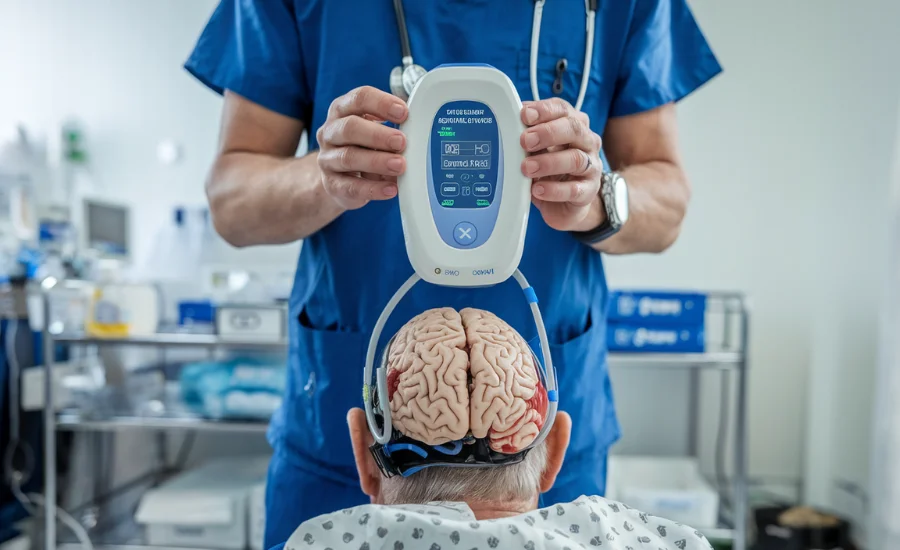EVD Device LTAC Facility In Long-Term Acute Care (LTAC) facilities, the use of an External Ventricular Drain (EVD) device is crucial for patients needing specialized neurological treatment. An EVD device plays a key role in managing intracranial pressure by channeling cerebrospinal fluid (CSF) from the brain’s ventricles to an external system. This procedure is vital for stabilizing patients with severe neurological conditions. This article delves into the importance, functionality, and effective management of EVD devices within LTAC facilities, highlighting their essential role in the treatment and care of critically ill neurological patients.
EVD Device LTAC Facility: Essential Tools for Managing Intracranial Pressure

Catheters called External Ventricular Drain (EVD) Devices are surgically inserted catheters that are intended to monitor intracranial pressure (ICP) and remove extra cerebrospinal fluid (CSF) from the brain’s ventricles. EVD devices play a crucial role in preventing subsequent brain injuries associated with raised intracranial pressure (ICP) in Long-Term Acute Care (LTAC) facilities, where patients frequently require prolonged observation and treatment. These devices assist in maintaining the ideal cerebral perfusion pressure (CPP), which ensures enough oxygenation to the brain and reduces the danger of additional neurological damage, by efficiently controlling CSF levels. Better outcomes in the recovery process are supported by this precise control, which is essential for treating patients undergoing neurosurgical procedures or recovering from serious brain injuries.
EVD Device LTAC Facility: Vital Support for Neurological Care
An External Ventricular Drain (EVD) is a short-term, vital mechanism for treating neurological disorders such as traumatic brain injury, hydrocephalus, and other problems causing cerebrospinal fluid (CSF) accumulation. The EVD device allows controlled drainage and external monitoring of CSF, which is crucial for controlling intracranial pressure, by inserting a catheter into the brain’s ventricles. By lowering the hazards associated with elevated intracranial pressure, the EVD device is a life-saving tool that helps stabilize patients’ conditions in Long-Term Acute treatment (LTAC) facilities, where extended treatment and surveillance are crucial.
In LTAC settings, the role of the EVD device goes beyond temporary relief. It becomes a critical element in providing consistent monitoring and careful management of fluid levels to prevent dangerous fluctuations in intracranial pressure. This constant vigilance is key to minimizing further damage to brain tissue, supporting patients through their recovery from severe neurological events, and enhancing their chances of better long-term outcomes.
Advancements in EVD Device Technology for LTAC Settings: Enhancing Neurocritical Care
In recent years, there have been remarkable innovations in External Ventricular Drain (EVD) device technology, significantly improving their precision, safety, and usability in Long-Term Acute Care (LTAC) environments. Modern EVD devices now come equipped with advanced pressure monitoring systems that offer real-time data on intracranial pressure (ICP), enabling healthcare providers to make quick adjustments to drainage rates and treatment plans. This real-time feedback is critical in managing the delicate balance required in neurocritical care.
EVD Device LTAC Facility The most recent EVD models also have closed-loop drainage systems, which significantly lower the risk of infection by maintaining a sterile environment surrounding the catheter site. These closed systems offer a more regulated and reliable method of controlling intracranial pressure in addition to improving the effectiveness of cerebrospinal fluid (CSF) outflow. at addition to improving patient outcomes, these technology developments are also simplifying the workflow at LTAC facilities, enabling more focused and efficient management of patients in need of specialist neurological care.
Specialized Neurological Care in LTAC Facilities: Managing EVD Devices with Precision
Facilities that specialize in providing intensive medical care for individuals with severe, long-term health issues are known as Long-Term Acute Care (LTAC) facilities. Providing the ongoing and specialized care that patients with chronic illnesses or those recovering from major surgeries require, these facilities assist people. The perfect setting for careful observation and knowledgeable care is offered by LTAC facilities for neurological patients who need to use an External Ventricular Drain (EVD) device.
The administration of EVD devices in LTAC settings is overseen by a group of extremely skilled medical specialists with particular expertise in neurological care. These professionals are in charge of monitoring cerebrospinal fluid (CSF) drainage closely in order to make sure the system runs smoothly and doesn’t get clogged or infected. Because minor problems might worsen into major complications, LTAC clinics place a strong emphasis on keeping the area surrounding the EVD device sterile and closely monitoring the patient’s neurological status. This extreme caution is necessary to avoid any side effects that can jeopardize the patient’s recuperation and general neurological health.
Comprehensive Management of EVD Devices in LTAC Facilities: Ensuring Patient Safety and Optimal Outcomes
In clinical practice, the deployment of External Ventricular Drain (EVD) devices within Long-Term Acute Care (LTAC) facilities demands a high level of precision and continuous care from a multidisciplinary healthcare team. Neurocritical care specialists play a central role in using these devices to develop individualized treatment plans, adjusting strategies based on each patient’s unique neurological needs and responses. The real-time monitoring of intracranial pressure (ICP) enables early detection of any changes, allowing for immediate modifications to drainage rates and therapeutic approaches to stabilize the patient’s condition.
Strict adherence to best standards, such as sterile insertion techniques, routine catheter maintenance, and watchful observation for any symptoms of infection or device-related concerns, provides the foundation for effective EVD management in LTAC settings. EVD Device LTAC Facility These rigorous procedures are essential for improving the overall effectiveness of neurocritical care interventions as well as for ensuring patient safety. LTAC facilities make sure that patients receive the best treatment possible, specifically designed to support neurological health and the best possible recovery, by concentrating on these crucial EVD device management features.
Preventing Infections in EVD Device Management at LTAC Facilities
EVD Device LTAC Facility One of the primary challenges in using an External Ventricular Drain (EVD) device is the heightened risk of infection. Given that the device involves direct access to the brain, any compromise in sterility can have severe consequences, potentially leading to serious conditions like ventriculitis or meningitis. Infection control is therefore a critical focus in Long-Term Acute Care (LTAC) facilities, where patients often have weakened immune systems and extended recovery periods.
It need constant attention to sterile procedures and infection control guidelines to manage EVD devices in LTAC environments. This entails vigilant cleaning of the catheter insertion site, regular drainage system replacements, and ongoing infection control monitoring. To avoid problems, indicators such as fever, altered properties of the cerebrospinal fluid (such as cloudiness or the presence of blood), or changes in mental status must be promptly diagnosed and treated. The focus on infection control guarantees the efficacy of neurocritical care provided by the facility while also protecting patient health.
Challenges in Managing EVD Devices in LTAC Facilities
While treating neurological diseases with EVD devices has many benefits, there are unique issues associated with managing these devices in Long-Term Acute Care (LTAC) institutions that need to be carefully considered. The possibility of catheter-related infections, which can result in life-threatening side effects including meningitis or ventriculitis, is one of the most urgent worries. Strict adherence to aseptic procedures is essential for the device’s implantation and continuous maintenance in order to reduce this danger. Key measures in avoiding these consequences include timely beginning of targeted antibiotic medication and routine monitoring for early indications of infection.
Significant dangers also arise from mechanical problems, such as catheter obstructions or dislodgments, which can impair the drainage of cerebrospinal fluid (CSF) and cause dangerously high intracranial pressure (ICP). Resolving these problems quickly is essential to continuing treatment that works. Comprehensive staff training and adherence to standardized protocols are essential components in overcoming these challenges, ensuring that patients in LTAC settings receive the highest standard of care when relying on EVD devices for their neurocritical needs.
Advancing EVD Device Technology: Innovations Shaping the Future of Neurocritical Care

Research and development initiatives to further improve the functioning and safety of EVD devices hold great promise for the field of neurocritical care. Modern developments center on incorporating complex sensor technology for ongoing biochemical marker monitoring in cerebrospinal fluid (CSF). With more accurate understanding of a patient’s neurological condition made possible by this breakthrough, individualized treatment plans catered to each patient’s need may be possible.
The investigation of minimally invasive EVD installation methods in conjunction with the application of novel materials intended to enhance biocompatibility represents another noteworthy area of advancement. The aforementioned advancements are designed to mitigate procedural hazards, augment patient comfort, and optimize the treatment procedure as a whole. Furthermore, clinical decision-making is about to undergo a revolution because to developments in data analytics and digital health technology, giving healthcare providers
These innovations are poised to transform neurosurgical and neurocritical care, particularly in Long-Term Acute Care (LTAC) facilities. By harnessing these technological advancements, healthcare professionals will be better equipped to improve the recovery process for patients suffering from severe neurological injuries or undergoing complex neurosurgical procedures, ultimately enhancing their quality of life and long-term prognosis.
Read More: Absolute Junk NYT
Comprehensive Care for Neurological Patients Using EVD Devices in LTAC Facilities
Patients in Long-Term Acute Care (LTAC) facilities who rely on External Ventricular Drain (EVD) devices often face extended recovery periods due to the complexity and severity of their neurological conditions. LTAC facilities are specifically equipped to offer both medical management of the EVD device and specialized rehabilitation services, ensuring that these patients receive the comprehensive care they need.
As a patient’s condition begins to improve, the healthcare team gradually works to reduce reliance on the EVD device, aiming to eventually remove it once intracranial pressure (ICP) levels stabilize. Throughout this critical phase, the EVD device plays an essential role in maintaining safe ICP levels, enabling healthcare professionals to closely monitor and manage cerebrospinal fluid (CSF) drainage.
The process of returning normal fluid circulation after active CSF drainage is a sensitive one that needs to be carefully monitored by medical professionals. LTAC facilities give patients the best chance for a full recovery by providing the individualized treatment and ongoing monitoring required to make this transition as easy as possible. In these specialist facilities, patients get targeted medical management along with rehabilitative support that improves their outcomes and directs them toward a safer and more efficient road to recovery.
Final Words
EVD Device LTAC Facility External Ventricular Drain (EVD) devices are essential tools for Long-Term Acute Care (LTAC) hospitals’ neurocritical care patient management. These devices are extremely helpful to medical teams since they monitor and control the dynamics of cerebrospinal fluid (CSF) and intracranial pressure (ICP).
The effectiveness of EVD devices is increased by continuous technological improvements and strict clinical guidelines, which empower medical professionals to deliver individualized and efficient care that greatly improves patient outcomes while maintaining safety. Exciting new advancements that will expand the capabilities of EVD devices and increase their uses in LTAC contexts are expected as a result of the ongoing focus on research and innovation in neurosurgery and neurocritical care.
By proactively addressing existing challenges and embracing new opportunities, healthcare providers can set a higher standard of care for patients who depend on EVD devices as they navigate their recovery from neurological injuries and disorders. This commitment to excellence in patient care underscores the transformative potential of EVD technology in supporting the healing journey of vulnerable patients in LTAC facilities.
For More Information Check It Out Discover Out
